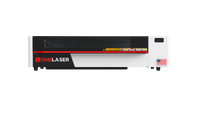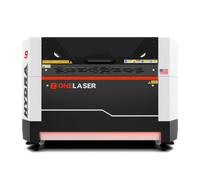When researching how to start a laser cutting business, understanding the technical, financial, and market factors is essential. From identifying target products to selecting the right machine, this guide covers key steps including niche selection, equipment setup, marketing, and pricing.
Whether you're asking, "Is laser cutting a good business?" or looking for the best laser cutting machine for a small business, this structured approach helps you plan efficiently.
Key Takeaway
Starting a laser cutting business can be highly profitable if approached with the right strategy, choosing a niche, investing in the right CO₂ laser machine, setting up a functional workshop, mastering design/software skills, and pricing services wisely. Success depends on careful planning, strong marketing, ongoing skill development, and maintaining your equipment. With demand for personalized products and custom parts on the rise, a well-executed laser cutting business offers strong long-term potential.

1. Understanding the Laser Cutting Business Model
The laser cutting business operates by offering customized cutting, engraving, and marking services. It applies across industries from retail personalization to industrial manufacturing.
- Common Service Types: Signs, gifts, and industrial parts. Each requires different machine setups and software skills.
- Revenue Models: Per-piece pricing, batch orders, or subscription services for repeat clients. For instance, some shops focus solely on bulk orders for corporate branding, while others handle custom one-offs.
- B2B vs. B2C Focus: Industrial cutting versus personalized retail products. Deciding early affects equipment choice and pricing strategy. A B2B model may need larger machines and formal contracts; B2C might rely more on e-commerce and quick turnaround.
Market Research and Niche Selection
Profitable laser cutting businesses focus on high-demand, low-competition niches.
- How to Research: Use tools like Google Trends, Etsy search, and competitor analysis. Analyze keyword search volumes for terms like "laser engraved wood" or "personalized cutting boards."

- Top Niches: Custom signage, wedding décor, branded merchandise, fashion accessories, and prototype parts.
Learn more: Laser Cut Ideas for Weddings
- Trend Analysis: Monitor seasonal patterns in personalization demand or industrial material needs. For example, wedding seasons often increase demand for acrylic table numbers or custom invitations.
2. Choosing the Best Laser Cutting Machine for Small Business
When evaluating how to start a laser cutting business, selecting the right equipment is a critical decision that directly affects product quality, workflow efficiency, and long-term return on investment.
Your machine needs to match your primary materials, production scale, and budget without compromising reliability.
2.1 CO₂ vs. Fiber Lasers for Small Business Use
- CO₂ laser cutters: Best suited for wood, acrylic, leather, fabrics, rubber, and paper products. CO₂ machines deliver clean edges and are especially popular for signage, custom gifts, and apparel decoration.
- Fiber Laser Cutters: Optimized for cutting metals like stainless steel, aluminum, and brass. They operate at a different wavelength (1.06 μm) and typically require higher upfront investment.
For most small businesses focusing on products like wood signs, acrylic items, and fabric-based goods, CO₂ laser cutters offer the best balance of affordability, versatility, and ease of use.
2.2 Key Features to Prioritize
- Bed Size: Mid-range bed sizes around 900×600 mm (23.6x11.8'') provide flexibility for both small and moderately large items. This format handles items from small engraved tags to multi-piece signage layouts.
- Power Rating: A laser cutting machine in the 60–150 W range covers both engraving and cutting across various thicknesses. Lower-wattage units may struggle with thicker materials or slow down production.
- Air Assist System: Essential for clean cuts on wood and acrylic while protecting optics from soot buildup.
- Auto-Focus Function: Improves precision and workflow speed, especially when switching between materials of different thicknesses.

2.3 Budget Consideration and Long-Term Value
While entry-level machines can cost as little as $2,000, most serious businesses benefit from investing in mid-range machines priced around $5,000–$15,000. This range typically includes higher build quality, better support, and more robust software integration. Avoid ultra-cheap units, cutting performance, machine stability, and part replacement availability often suffer.
2.4 Why OneLaser X Series and Hydra Series Are Strong Choices
For businesses asking, "what's the best laser cutting machine for small business?" both the OneLaser X Series and OneLaser Hydra Series stand out for their reliability, configurability, and industrial-quality build:
OneLaser X Series:
Designed for professional hobbyists and light production environments. It combines mid-size bed dimensions (commonly 900x600 mm / 23.6x11.8'') with features like integrated air assist and optional autofocus, offering a highly accessible platform for mixed-material work. It's ideal for custom signage, gifts, and small-batch engraving businesses.
Discover the OneLaser X Series!

OneLaser Hydra Series:
Built for higher-output shops and industrial settings. With reinforced gantries, dual-laser capabilities (CO₂ DC + RF options), and advanced motion control, Hydra Series machines handle larger jobs, thicker stock, and continuous-use demands. Its adjustable bed and knife-blade table allow flexible setups for complex projects.
Discover the OneLaser Hydra Series!

Both series strike a balance between affordable initial cost and professional-grade performance, backed by software support for LightBurn and RDWorks.
Learn more: Best Laser Engraving Software
Investing in these platforms helps new businesses avoid the pitfalls of outgrowing their first machine too quickly or facing inconsistent quality.
3. Workshop Setup And Core Skill Mastering
A well-planned workshop and strong operator skills are essential for running a smooth, efficient laser cutting business. Your workspace directly affects production flow, safety, and consistency, while your ability to handle software and machine settings impacts the quality and reliability of each job.
3.1 Space and Equipment Planning
Allocate a dedicated area (at least 200–300 square feet) to house your laser machine, materials, tools, and ventilation system. A cramped or cluttered setup slows down workflow and increases safety risks.
Essential items include:
- Laser Cutting Machine: Sized to match your target product dimensions.
- Exhaust System: Critical for removing smoke and fumes, especially when processing wood, acrylic, or rubber.
- Air Compressor or Air Assist Unit: Improves cut quality and protects optics.
- Material Storage Racks: Keep sheet goods organized and accessible.
- Safety Gear: Fire extinguishers, protective eyewear, and first-aid supplies.
- Design Workstation: A reliable computer equipped with design software like LightBurn, CorelDRAW, or Illustrator.
- Workbench and Tools: For cleaning, post-processing, and general setup.

3.2 Environmental Considerations
Maintain a clean, temperature-controlled workspace. Avoid dust buildup, as it can interfere with optics and mechanical components. Keep room temperature stable—typically between 15–25°C—to protect machine electronics and materials. Install fire suppression systems rated for laser cutting operations.
3.3 Developing Operator Skills
Beyond equipment setup, mastering both machine operation and software workflows is essential for delivering consistent, high-quality results.
- Design Software Mastery: Learn how to create, import, and edit vector files using LightBurn, CorelDRAW, or Illustrator. Proper file preparation ensures cut paths are optimized and engraving quality meets client expectations.
- Machine Operation Fundamentals: Understand how to adjust laser focus, set power and speed parameters, and test materials. Mistakes like incorrect Z-height or power settings can ruin jobs or damage equipment.
- Troubleshooting and Maintenance: Develop a habit of diagnosing and fixing issues such as beam misalignment, focus drift, or inconsistent cutting. Keep a maintenance log to track lens cleaning, air assist checks, and mechanical inspections.

Combining smart workshop layout with technical competency reduces downtime, improves customer satisfaction, and helps your laser cutting business scale more effectively.
4. Pricing Your Laser Cutting Service
4.1 Pricing Your Laser Cutting Service
A clear pricing structure directly addresses the question: is laser cutting business profitable? The answer depends on how well you balance cost coverage, competitive market rates, and profit margins.
a. Cost Calculation
When setting prices, account for:
- Machine Wear: CO₂ laser tubes and optics require replacement or service every 1–3 years depending on usage.
- Materials: Acrylic, wood blanks, stainless tumblers, or skateboard decks all have varied costs.
- Electricity and Labor: Running large machines or rotary attachments uses more power. Don't forget operator time and post-processing labor.
- Maintenance: Regular cleaning, calibration, and parts replacement should be factored into your hourly rate.
b. Pricing Strategies
-
Time-Based Pricing:
Charge by machine runtime. A standard range is $1–$4 per minute, depending on machine size and material. Suitable for bulk orders or precise cut-time tracking. -
Per-Piece Pricing:
Set flat rates for common products, ideal for retail and e-commerce. Examples:- Custom tumbler engraving: $20–$40 per piece
- Skateboard deck engraving: $80–$150 each, depending on coverage area
- Wooden spoon engraving: $10–$18 each
- Wooden bowl pattern engraving: $25–$60 each
-
Value-Based Pricing:
Price items not just by material cost or time but by perceived customer value. For example:- Custom wooden wall art can cost $200–$500 even if material cost is low because of size, uniqueness, and personalization.
- Premium engraved cups or wedding gifts may sell for 3–5× the base material and labor cost.
c. Market Comparison
Regularly check what similar products sell for on platforms like Etsy, Amazon Handmade, or local B2B service providers. Adjust your pricing to stay competitive while maintaining healthy margins.
d. Example Breakdown Table
|
Product |
Material |
Machine Time |
Suggested Price |
|
Powder-Coated Steel |
5–10 min |
$20–$40 each |
|
|
Skateboard Deck |
Maple or Bamboo |
20–30 min |
$80–$150 each |
|
Hardwood |
2–5 min |
$10–$18 each |
|
|
Wooden Bowl |
Acacia or Maple |
10–15 min |
$25–$60 each |
|
Wooden Wall Art (Large) |
MDF or Birch |
30–60 min |
$200–$500+ |
|
Engraved Ceramic Cup |
Glazed Ceramic |
8–12 min |
$18–$35 each |
5. Marketing and Promoting Your Laser Cutting Business
Strong marketing brings in consistent customer traffic.
- Digital Marketing: Build an SEO-optimized website targeting terms like "custom laser cut signs" or "engraved gifts." Run local Google Ads or Facebook campaigns.
- Content Production: Create video demonstrations, how-to blog posts, and social media updates showcasing recent projects. These help build trust and visibility.
- Customer Retention: Implement loyalty programs offering discounts on repeat orders. Collect customer emails for newsletters announcing new products or promotions.
6. Legal Setup, Licensing, and Safety Compliance
Compliance ensures smooth operation and protects against fines or lawsuits.
- Business Registration: Set up an LLC or sole proprietorship. LLCs provide legal protection for personal assets.
- Licenses and Permits: Obtain local business licenses, zoning approval, and register for sales tax where applicable.
- Safety Equipment: Equip your workshop with fire extinguishers, laser safety glasses, ventilation systems, and first-aid kits. Keep a material safety data sheet (MSDS) on file for each processed material.
7. Common Mistakes New Laser Cutting Businesses Make
Avoiding early missteps improves profitability and growth potential.
- Equipment Misalignment: Buying a machine too small or underpowered for your target market leads to lost business opportunities.
- Pricing Errors: Underestimating overheads like rent, electricity, and labor results in unsustainable pricing.
- Marketing Oversights: Relying solely on word-of-mouth is risky. Build structured online marketing strategies from the beginning.
- Maintenance Neglect: Skipping regular maintenance (like cleaning optics or checking belts) reduces machine life and increases repair costs.
8. FAQs
Q1. Is laser cutting a good business?
Yes—especially in markets like personalized gifts, signage, and industrial part prototyping. Success depends on finding the right niche, offering consistent quality, and building a strong customer base.
Q2. What is the best laser cutting machine for small business use?
A mid-range CO₂ laser cutter (60–150 W) with a bed size of around 600×900 mm is ideal for most startups. It balances cutting power, engraving detail, and workspace flexibility.
Q3. Is laser cutting business profitable in 2025 and beyond?
It can be, especially with rising demand for personalization and rapid prototyping. Profit margins are strong if pricing covers all hidden costs like machine maintenance and marketing.
Q4. How much investment is needed to start a laser cutting business?
Starting costs typically range from $7,000 to $20,000, covering the machine, workshop setup, initial materials, and marketing expenses.
Q5. Can I run a laser cutting business from home?
Yes, provided your setup complies with local zoning laws and you have adequate ventilation and fire safety measures in place.
Have Questions? Contact Us Now!
Conclusion
If you're asking, "is laser cutting business profitable?" the answer depends on preparation, execution, and scaling. From picking the best laser cutting machine for small business use to building strong marketing channels and pricing models, these steps help structure your journey from startup to successful business. Thoughtful setup and continuous skill development position your laser cutting business for long-term success.

 Liquid error (sections/image-banner line 171): invalid url input
Liquid error (sections/image-banner line 171): invalid url input





